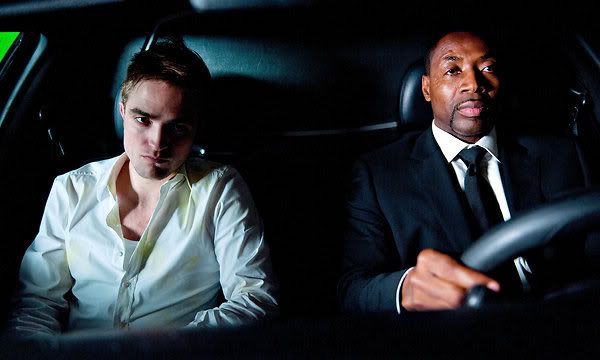THE social theorist Marshall McLuhan famously described media as “extensions of man.” The filmmaker David Cronenberg, a fellow Canadian, has made several movies that count as mind-bending elaborations of that insight.
In “Videodrome” (1983) a video signal embedded in a pornographic cable broadcast causes hallucinations and bodily transformations in its viewers. The game players of “eXistenZ” (1999) download alternate realities by plugging squishy protoplasmic pods directly into their spines. Mr. Cronenberg’s latest film,“Cosmopolis,” takes place in a spectral world of global capital, digital information and virtual everything. Its currency-trading billionaire hero, cocooned in a white stretch limousine that serves as a second skin, deals and speaks in abstractions and is himself something of a hologram, an inscrutable young master of a conceptual universe.
“Cosmopolis,” due Aug. 17 from eOne, follows the suave Eric Packer (played by the“Twilight” heartthrob Robert Pattinson) on what proves to be a day of reckoning. Inching through Manhattan traffic for a haircut on the other side of town, he receives a succession of experts and analysts in his leather-upholstered sanctum, which doubles as a boardroom, a bedroom and even a doctor’s office. External distractions — a presidential motorcade, anti-capitalist demonstrations — appear through tinted windows and on touch screens. Everything happens and is experienced at a dreamlike remove. Eric’s bet against the Chinese yuan has turned disastrous, but he responds with eerie detachment, numbly contemplating the prospect of his economic and actual extinction.
Based on a 2003 novel by Don DeLillo, “Cosmopolis” merges the distinctive sensibilities of a filmmaker and a novelist who have both been called prophetic, a shorthand way of saying that both have their antennas up for the larger forces — language, technology, the collections of images and systems of knowledge — that shape our world and our sense of reality. Films and footage, like the Zapruder home movie in “Libra,” often play crucial roles in Mr. DeLillo’s books, but while several of his novels have been optioned for adaptation — “White Noise” and “Libra” were in the works for years — until now all had stalled in development.
“Cosmopolis” is hardly obvious screen material on the page. But Mr. Cronenberg has located cinematic life in other novels that many would deem unfilmable, whether for being too bizarre (William S. Burroughs’s “Naked Lunch”), too graphic (J. G. Ballard’s“Crash”) or too interior (Patrick McGrath’s “Spider”).
In an interview at the Cannes Film Festival, where “Cosmopolis” had its premiere in May, Mr. Cronenberg spoke about his approach to adaptation. “You have to betray the book in order to be faithful to the book,” he said. “You have to recognize that literature is not cinema.”
But “Cosmopolis,” which some critics in Cannes faulted for being too static, is an almost perversely faithful rendition of the book. On the phone from Toronto recently, Mr. Cronenberg said that claustrophobia was very much the point. “I love the ascetic idea of so much happening within a limo,” he said. “I don’t find that it forces you into monotony. Quite the opposite, it forces you to be innovative.”
He looked at films that were restricted to cramped locations — the submarine-set “Das Boot,” and “Lebanon,” which unfolds inside an Israeli tank — and he even moved one scene, an encounter between Eric and his art dealer, from an apartment into the car.
Mr. DeLillo, for one, might argue that there is something inherently cinematic about this contained structure. His one produced screenplay to date — for the 2005 indie “Game 6” — is also about a character stuck in traffic, trying to get from point A to B. “A man on a horse crossing the screen from right to left, or left to right — there’s something about that that strikes me as the essence of American cinema,” Mr. DeLillo said in a recent phone interview from his home in New York. “In this case we have a man in a limousine who’s crossing the screen in a rather different way of course. But it’s that idea of a journey that will be resolved in the simplest and maybe the most violent possible way.”
The limo built for the film was a “Lego-like modular structure,” Mr. Cronenberg said. “It had to come apart for lighting, for sound, for camera.” In keeping with Eric’s stipulations that his car be “prousted” — lined with cork, à la Proust’s room, to shut out the din of the outside world — Mr. Cronenberg instructed his sound designers to keep the limo scenes free of ambient noise. Not even the hum of the engine is audible.
This airless bubble is an oddly apt vessel for Mr. DeLillo’s heightened language, which Mr. Cronenberg transcribed almost verbatim. (He wrote the script in a mere six days.) “It’s very stylized,” Mr. Cronenberg said of Mr. DeLillo’s dialogue, “but it also taps into some inner rhythms of the American psyche.”
Some reviewers were put off by the novel’s clipped cadences — Walter Kirn in The New York Times Book Review described the dialogue in the book as “an unholy collaboration between Harold Pinter and Robby the Robot” — but Mr. Cronenberg embraced the artifice. “I can hear naturalistic dialogue any day on the street,” he said. “What I wanted was not just to hear this dialogue spoken but to see actors embody it. They bring it to life in a physical, corporeal way.”
Amid a revolving door of mostly female visitors played by the likes of Juliette Binoche and Samantha Morton, the impassive constant is Mr. Pattinson. “I don’t think Rob’s face has ever been examined in such excruciating detail, from so many angles,” Mr. Cronenberg said. “That was part of the casting. You want a face that can take that.”
NYTimes Thanks ToR Via PatStewBoneCT


Inga kommentarer:
Skicka en kommentar